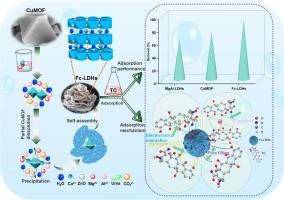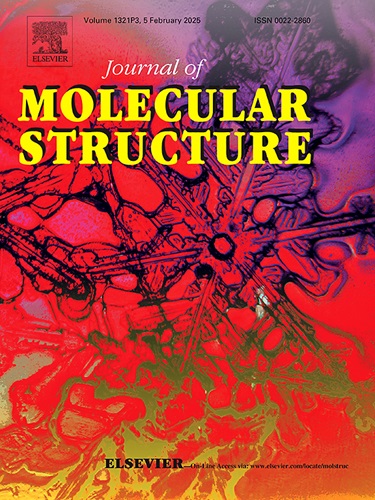Fabrication of 3D flower-shaped MgAl-LDHs with inducing CuMOF for improving its adsorption and antibacterial performance
IF 4
2区 化学
Q2 CHEMISTRY, PHYSICAL
引用次数: 0
Abstract
Chronic and inappropriate use of antibiotics, antibiotic residue, and bacterial infections present a significant threat to both the environment and human health. This study focused on the effective remediation of wastewater contaminants through the synthesis of Cu-based metal-organic framework (CuMOF) conjugated with layered double hydroxide (LDHs) via hydrothermal processing, resulting in the development of a novel three-dimensional (3D) flower-shaped CuMOF@LDHs (Fc-LDHs) hybrid materials. After being characterized by SEM, FT-IR, XRD, zeta potential and BET, the obtained Fc-LDHs was applied to adsorption of antibiotics, and its antibacterial activity was also investigated. It indicated that Fc-LDHs exhibited excellent performance in both adsorption and antibacterial activity. Utilizing tetracycline (TC) as a representative antibiotic, the influence of various parameters on the adsorption efficiency was examined. The study revealed that an adsorbent mass of 0.08 g could achieve a removal efficiency of 94.2 % for TC at an initial concentration of 50 mg/L within 90 min, with the removal rate remaining at 72.6 % after four cycles of adsorption-desorption. It was also found that the adsorption mechanism was consistent with the Freundlich isothermal model and the pseudo-second-order kinetic model. The exceptional adsorption properties were primarily ascribed to the synergistic effects of electrostatic interactions, pore filling, chelation and hydrogen bonding interactions between Fc-LDHs and TC. Simultaneously, the antibacterial rates of Fc-LDHs reached to 90.3 % and 95.7 % against Escherichia coli (E. coli) and Staphylococcus aureus (S. aureus), respectively. In conclusion, Fc-LDHs proved to be a highly efficient remedy for addressing antibiotic and antibacterial pollution, functioning both as a proficient adsorbent and antibacterial agent.

用诱导型 CuMOF 制备三维花状 MgAl-LDHs 以改善其吸附和抗菌性能
抗生素的长期不当使用、抗生素残留和细菌感染对环境和人类健康都构成了严重威胁。本研究的重点是通过水热处理合成铜基金属有机框架(CuMOF)与层状双氢氧化物(LDHs),从而开发出一种新型三维(3D)花形 CuMOF@LDHs(Fc-LDHs)杂化材料,以有效修复废水污染物。在对得到的 Fc-LDHs 进行了 SEM、FT-IR、XRD、ZETA 电位和 BET 表征后,将其用于吸附抗生素,并研究了其抗菌活性。结果表明,Fc-LDHs 在吸附和抗菌活性方面均表现出优异的性能。以四环素(TC)为代表抗生素,研究了各种参数对吸附效率的影响。研究发现,吸附剂质量为 0.08 克时,在 90 分钟内对初始浓度为 50 毫克/升的 TC 的去除率可达 94.2%,经过四次吸附-解吸循环后,去除率仍为 72.6%。研究还发现,吸附机理符合 Freundlich 等温模型和假二阶动力学模型。Fc-LDHs 与 TC 之间的静电作用、孔隙填充、螯合作用和氢键作用的协同效应是其优异吸附性能的主要原因。同时,Fc-LDHs 对大肠杆菌和金黄色葡萄球菌的抗菌率分别达到 90.3% 和 95.7%。总之,Fc-LDHs 被证明是解决抗生素和抗菌污染问题的一种高效疗法,它既是一种吸附剂,又是一种抗菌剂。
本文章由计算机程序翻译,如有差异,请以英文原文为准。
求助全文
约1分钟内获得全文
求助全文
来源期刊

Journal of Molecular Structure
化学-物理化学
CiteScore
7.10
自引率
15.80%
发文量
2384
审稿时长
45 days
期刊介绍:
The Journal of Molecular Structure is dedicated to the publication of full-length articles and review papers, providing important new structural information on all types of chemical species including:
• Stable and unstable molecules in all types of environments (vapour, molecular beam, liquid, solution, liquid crystal, solid state, matrix-isolated, surface-absorbed etc.)
• Chemical intermediates
• Molecules in excited states
• Biological molecules
• Polymers.
The methods used may include any combination of spectroscopic and non-spectroscopic techniques, for example:
• Infrared spectroscopy (mid, far, near)
• Raman spectroscopy and non-linear Raman methods (CARS, etc.)
• Electronic absorption spectroscopy
• Optical rotatory dispersion and circular dichroism
• Fluorescence and phosphorescence techniques
• Electron spectroscopies (PES, XPS), EXAFS, etc.
• Microwave spectroscopy
• Electron diffraction
• NMR and ESR spectroscopies
• Mössbauer spectroscopy
• X-ray crystallography
• Charge Density Analyses
• Computational Studies (supplementing experimental methods)
We encourage publications combining theoretical and experimental approaches. The structural insights gained by the studies should be correlated with the properties, activity and/ or reactivity of the molecule under investigation and the relevance of this molecule and its implications should be discussed.
 求助内容:
求助内容: 应助结果提醒方式:
应助结果提醒方式:


